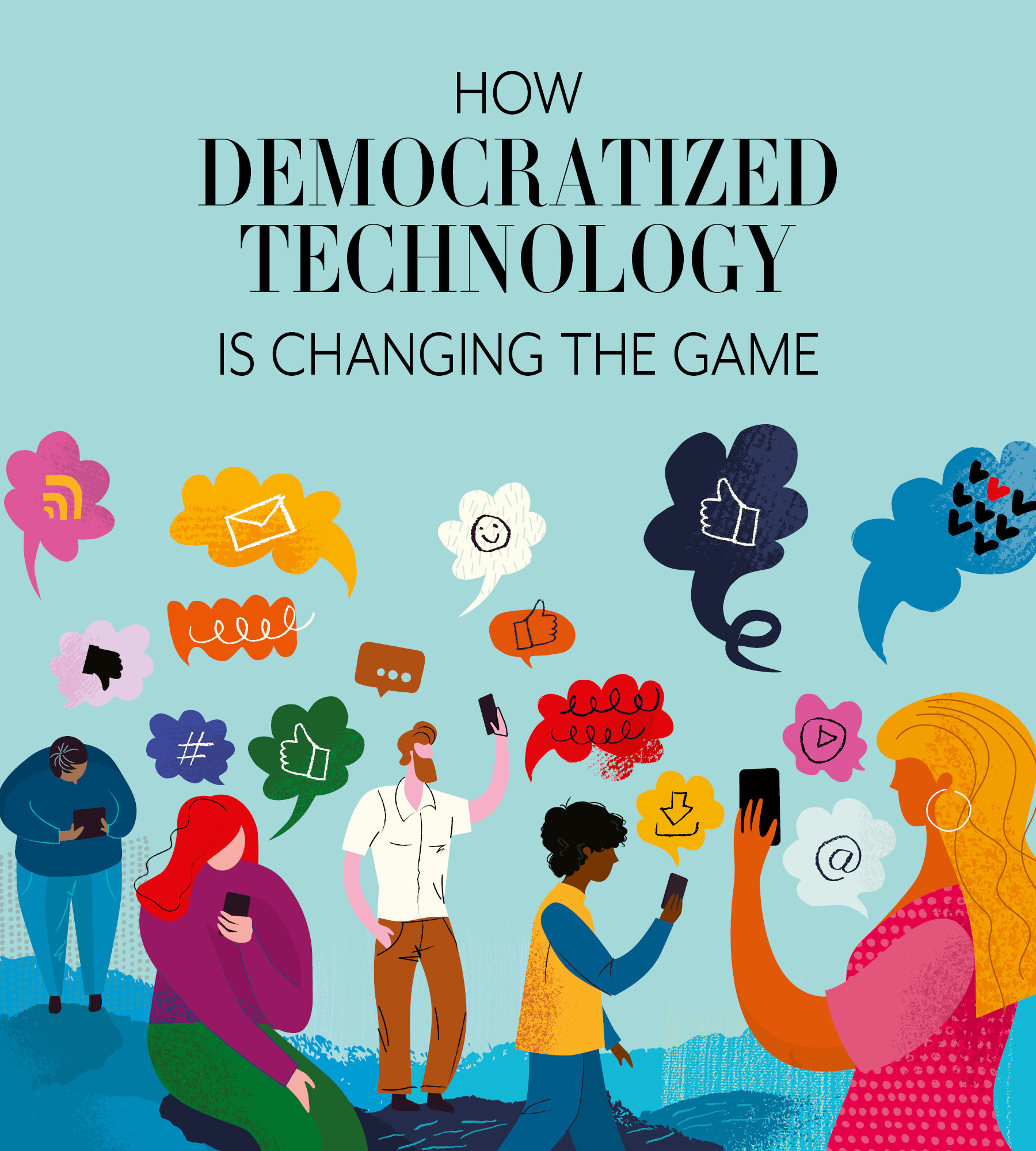Language
You can read the magazine in one of the following languages
The dominance of big tech companies like Google, Amazon, Facebook and Apple is unmatched. These industry giants rule over paramount sectors such as search engines, ecommerce platforms, social media networks and consumer electronics. But their towering presence has sparked concerns regarding market competition, data privacy and stifling of innovation.
However, there’s good news. A compelling movement toward democratized technology has emerged to make access to technology more inclusive, affordable and user-friendly for the mass population, rather than being restricted to a select few experts. Let’s explore how democratized technology is disrupting conventional paradigms and reshaping innovation.

The phenomenon of democratized technology empowers individuals and communities to leverage its benefits regardless of their background or expertise.
Democratized technology can manifest in various ways:
1. Affordability: Making technology more affordable ensures that a wider range of people can access it without significant financial barriers. This can involve reducing the cost of hardware, software or services.
2. Accessibility: Improving the accessibility of technology means making it easier for people with diverse abilities to use and interact with digital tools. This can include features such as screen readers, voice commands or adaptive interfaces.
3. Ease of Use: Simplifying technology interfaces and workflows makes it more approachable for individuals who may not have extensive technical knowledge or training. Intuitive design and user-friendly experiences are crucial in democratizing technology.
4. Education and Training: Providing educational resources, training programs and support networks help empower individuals to learn how to use technology effectively. This can include formal education in schools, online tutorials or community workshops.
5. Openness and Collaboration: Embracing open-source principles and fostering collaboration encourages innovation and allows a broader community to contribute to the development of technology. Open access to information and resources enables individuals to build upon existing tools and customize them to their needs.
As technology becomes more accessible, its goal is to shatter barriers and empower people from all walks of life to engage in and reap the benefits of the digital era. This inclusivity holds the promise of propelling social and economic advancement while increasing equality of opportunity. But progress is dependent on the cooperation of the tech giants.
Big tech companies have cemented their positions as innovation powerhouses, harnessing their vast resources and expansive user bases to propel technological progress. From Google’s groundbreaking search algorithms to Amazon’s ubiquitous ecommerce platform and Apple’s sleek and cutting-edge devices, these corporations have revolutionized entire industries, setting the gold standard for digital innovation.
Nonetheless, concerns loom large regarding their dominance, including worries over monopolistic practices, data privacy breaches and the stifling of competition. Consequently, there is a mounting call to challenge the existing order and cultivate a tech ecosystem that is more inclusive and diverse.
A significant barrier to innovation in this area is the exorbitant cost associated with technology, which can pose insurmountable hurdles for individuals and communities with limited resources.
Furthermore, the complexity of interfaces and technical jargon often alienates non-technical users, exacerbating the digital divide. Democratizing technology entails dismantling these barriers and empowering individuals from diverse backgrounds to partake in the digital revolution.
Accessibility and Affordability
Affordability serves as a pivotal factor in democratizing technology, widening its reach to encompass a broader audience. Affordable tech solutions such as Raspberry Pi, Arduino and budget-friendly smartphones have democratized access to technology, fostering innovation in developing nations and marginalized communities.
Initiatives like Google’s Android Go and Facebook’s Free Basics endeavor to bridge the digital chasm by providing low-cost internet access, empowering millions to connect and collaborate online.
User-Friendly Interfaces
User-friendly interfaces play a pivotal role in democratizing technology, enabling non-technical users to navigate digital landscapes with ease. The complexity of software and technical terminology can prove daunting for novices, impeding their ability to leverage technology to its fullest potential.
Platforms such as Canva for graphic design, WordPress for website creation and Wix for streamlined website building have demystified intricate tasks, rendering them accessible to a wider audience. Furthermore, the emergence of no-code and low-code platforms democratizes technology further by enabling users to craft applications without delving into intricate coding.
Open Source and Collaboration
Open-source software and collaboration serve as formidable catalysts in the democratization of technology, facilitating collective development and enhancement of software solutions. Projects such as Linux, Apache and WordPress have thrived due to the contributions of myriad developers worldwide.

Platforms like GitHub and GitLab foster collaboration, enabling developers to collaborate on projects irrespective of their geographical location or background. By embracing open-source principles, companies can nurture innovation, transparency and community-driven development.
Education and Training
Education and training represent vital pillars in the democratization of technology, equipping individuals with the requisite skills and knowledge to thrive in the digital landscape. Initiatives like Code.org, Khan Academy and Hour of Code, furnish students worldwide with free coding tutorials and resources, advocating digital literacy and STEM education.
Coding boot camps and online learning platforms such as Coursera and Udacity furnish accessible avenues for acquiring sought-after tech skills, empowering individuals to pursue tech careers regardless of their upbringing or locale.
Looking ahead, democratized technology will continue to reshape industries and propel innovation on a global scale. By democratizing access to knowledge, resources and economic opportunities, we can unlock the potential of countless aspiring entrepreneurs, innovators and creators worldwide.
Nonetheless, it remains imperative to strike a harmonious balance between innovation and regulation to safeguard a fair playing field and consumer rights. With the implementation of appropriate policies and initiatives, democratized technology harbors the potential to foster a more equitable and inclusive future for all.
So, what practical steps can organizations take to achieve a more democratic dispersion of technological power? One of the most intriguing concepts gaining momentum in management circles is the notion of decentralized decision-making and distributed leadership.
Traditional hierarchical structures often pose obstacles to innovation and agility, potentially hindering the flourishing of democratized technology within organizations. However, by embracing decentralized decision-making, individuals at all levels are empowered to contribute ideas, make decisions and propel initiatives forward.
Flattened Organizational Structures
Rather than adhering to rigid hierarchies, organizations are transitioning towards flatter structures that foster collaboration and autonomy. Breaking down silos and nurturing cross-functional teams allow companies to leverage the diverse expertise of their workforce and respond more swiftly to rapidly evolving market dynamics.
Zappos, the renowned online retailer, implemented a ‘holacracy’ model, replacing traditional hierarchical structures with self-organizing teams called ‘circles’. Zappos Holacracy approach encourages employees to take ownership of their work and collaborate across departments to achieve shared objectives.
Empowerment and Ownership
Granting employees the autonomy to make decisions instills a sense of ownership and accountability. When individuals feel empowered to take initiative and explore new ideas, they are more inclined to innovate and drive meaningful change within their roles.

Google’s ‘20 percent time’ policy allows employees to dedicate 20 percent of their workweek to projects of their choice. This initiative has catalyzed the development of innovative products such as Gmail and Google Maps, underscoring the impact of empowering employees to pursue their passions and experiment with new concepts.
Distributed Leadership
Departing from the conventional top-down approach, distributed leadership redistributes authority and responsibility throughout the organization. Leadership becomes a collective endeavor, with individuals assuming leadership roles based on their strengths and expertise.
Buurtzorg, a Dutch home care organization, operates with a model of self-managing teams where nurses wield significant autonomy in decision-making. This decentralized approach has yielded enhanced patient outcomes, heightened employee satisfaction and reduced administrative costs.
Agile Decision-Making Processes
Embracing agile methodologies enables organizations to make swift, data-driven decisions in response to evolving market conditions. Decentralizing decision-making authority and streamlining decision-making processes facilitate rapid adaptation to changes in technology, customer preferences and competitive landscapes.
Spotify employs a ‘squads and tribes’ model, empowering cross-functional teams (squads) to make autonomous decisions within a broader framework established by leadership (tribes). This agile approach facilitates rapid iteration, experimentation with new features, and staying ahead of competitors in the fast-paced music streaming industry.
Fostering a Culture of Experimentation
Encouraging a culture of experimentation and risk-taking is paramount for driving innovation and uncovering new opportunities. Creating a safe environment for employees to test out new ideas, learn from failures and iterate on their approaches unleashes the full creative potential of teams.
Amazon’s Day 1 philosophy underscores the importance of maintaining a startup mindset, even amid growth. This culture fosters constant experimentation with new products and services, innovation on behalf of customers and adaptability in the face of change.
The democratization of technology isn’t just reshaping management practices, it’s also having a profound cultural impact, challenging conventional notions of expertise and fostering a more inclusive approach to innovation.
The widespread availability of technology, coupled with its decreasing costs, has been instrumental in driving this cultural shift. As economies transitioned toward knowledge-based models, there emerged a growing demand for technological innovation, coupled with a sense of optimism about the potential for progress driven by technology.
Since the 1980s, there has been a growing recognition of the interconnectedness between technology and society. Scholars have emphasized that technology is far from neutral; social contexts and values shape its development and application. This perspective underscores the importance of considering societal implications when designing and deploying technology.

The emergence of democratized technology offers to break down barriers and drive innovation on a global scale.
Andrew Feenberg, a leading figure in the philosophy of technology, argues that democratizing technology involves expanding the design process to incorporate diverse interests and values. By doing so, technology can become more inclusive and responsive to the needs of different stakeholders. This suggests a participatory role for consumers, who can influence the direction of technological development through their engagement in the design process.
One notable outcome of technology democratization is the rise of the ‘do it yourself’ trend. Improved access to specialized knowledge and tools has empowered individuals to take on projects once reserved for experts. This trend has also blurred the lines between personal and professional technology use, as privately owned devices and software find applications in business settings. Some argue that this shift towards consumerization is reducing dependence on traditional IT departments as individuals take more control over their technological needs.
The rise of big tech companies has brought significant advancements but also raised concerns about monopolistic practices and privacy. However, the emergence of democratized technology offers to break down barriers and drive innovation on a global scale.
Furthermore, the shift toward decentralized decision-making and distributed leadership is not only transforming management practices but also redefining expertise and empowering individuals to take charge of their technological needs. As we embrace this cultural shift, we pave the way for a more inclusive and equitable future where everyone can participate and benefit from the digital age.

Muhammad Muzammil Rawjani
Contributor Collective Member
Muzammil Muzammil Rawjani is an accomplished entrepreneur and tech enthusiast with over 10 years of experience in software development. As the Co-Founder of TechnBrains, he brings his expertise as a seasoned software engineer to drive innovation and growth in the tech industry. With a strong passion for technology, Rawjani’s visionary leadership has propelled Technbrains to new heights, making it a prominent player in the market. To find out more visit https://www.technbrains.com/
